Entries from February 1, 2015 - February 28, 2015
Eurozone money growth surging before QE
Strong Eurozone January monetary statistics support the optimistic view here of economic prospects while casting doubt on the wisdom of next month’s launch of sovereign QE.
Narrow money M1 surged by 1.7% last month, with the broader M3 measure up by a solid 0.7%. Six-month growth rates rose to 5.8% for M1 and 2.6% for M3 (11.8% and 5.3% annualised) – the fastest since November 2009 and December 2008 respectively.
Real growth was further boosted by a larger six-month decline in consumer prices, mainly reflecting lower energy costs – see first chart.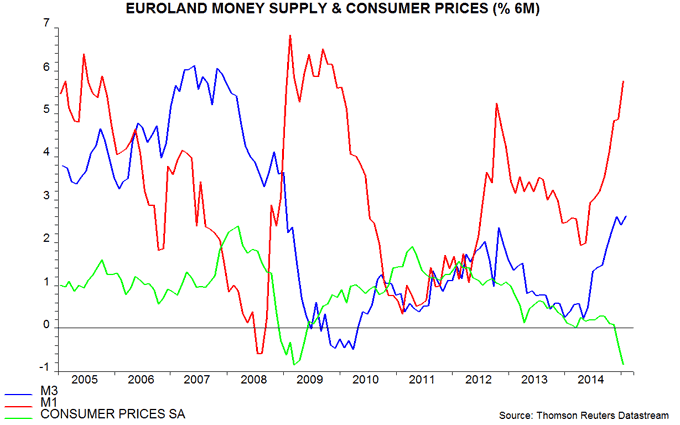
Six-month real M1 growth rose to 6.7%, or 13.7%, a level matched or exceeded in only two years since 1980 – 1999 and 2009. Industrial output and GDP subsequently rose strongly in both cases – second chart.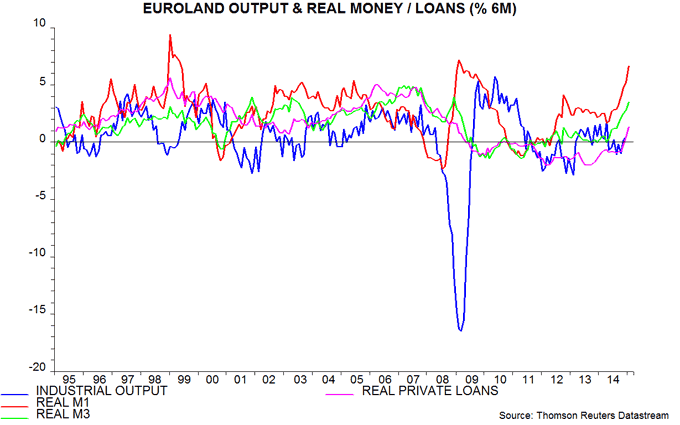
As well as signalling an economic pick-up, the current wide gap between real money and output growth suggests unusually favourable liquidity conditions for markets. Sovereign QE threatens to throw fuel on the flames, leading to destabilising asset price bubbles / busts.
M1, and to a lesser extent M3, have been boosted by the ECB’s rate cuts, which have reduced the opportunity cost of holding money. This does not reduce the significance of monetary strength for economic prospects. Faster money growth confirms that economic agents are responding to lower rates and are likely to increase spending on goods and services and investment in financial markets.
The country breakdown of overnight deposits, which dominate M1, shows strength across the big four economies. Six-month growth of real deposits surged in Italy and France last month and remains buoyant in Spain, with Germany lagging but solid – third chart.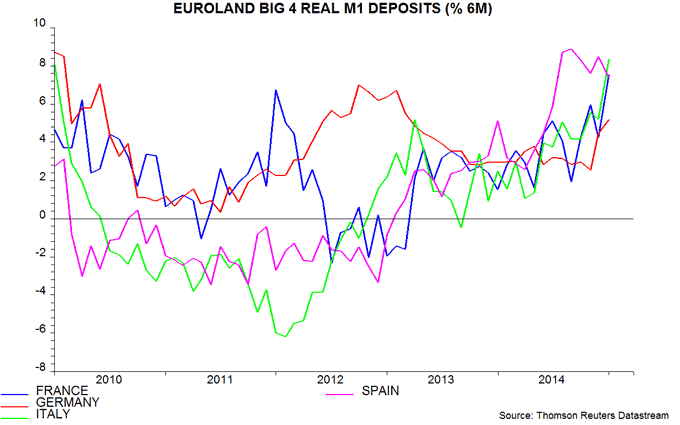
In other news today, German unemployment on an internationally-standardised definition fell to a new post-reunification low of 4.7% in January, far below current US / UK levels, while the job openings (vacancies) rate reached another record. Growing labour shortages should maintain upward pressure on wages – a regional branch of the IG Metall engineering union this week secured a 3.4% rise from 1 April despite weak consumer prices.
Liquidity backdrop for markets still favourable
The MSCI World index of developed equity markets this week reached a new record in US dollar terms. The local currency version of the index had surpassed its previous high in early February. The continued strength of equity markets is consistent with the assessment here of a favourable global liquidity backdrop.
According to the “monetarist” forecasting approach, real money – i.e. the money stock divided by prices, or M / P – leads the economy, while “excess” money – i.e. real money divided by output, or M / (P*Y) – leads financial markets. The latter idea suggests that equity markets will do well when real money is growing faster than output.
The first chart shows annual growth rates of G7 industrial output and real narrow money since 1970. Shaded areas mark periods when real money was growing faster than output, i.e. excess money was rising. The monetarist approach implies that equities should have performed more strongly during these periods.
This was the case. From the start of 1970 to the end of 2014, the MSCI World US dollar index returned a cumulative 314% more than US dollar cash (i.e. three-month eurodollar deposits). Investing in equities only when G7 excess money gave a positive signal would have boosted the excess return to 913%. By implication, equities underperformed cash on average during non-shaded periods.
The second chart compares the cumulative return relative to cash of buying-and-holding equities and a switching portfolio based on G7 excess money*. The maximum relative return drawdown of the switching portfolio in the historical data is 18% versus 56% for equities.
The annual growth rates of G7 real narrow money and industrial output were 7.3% and 1.7% respectively in November, the gap having widened since end-2013. A correction in markets is possible at any time but the liquidity backdrop remains supportive.
*The switching rule incorporates lagged as well as current excess money.
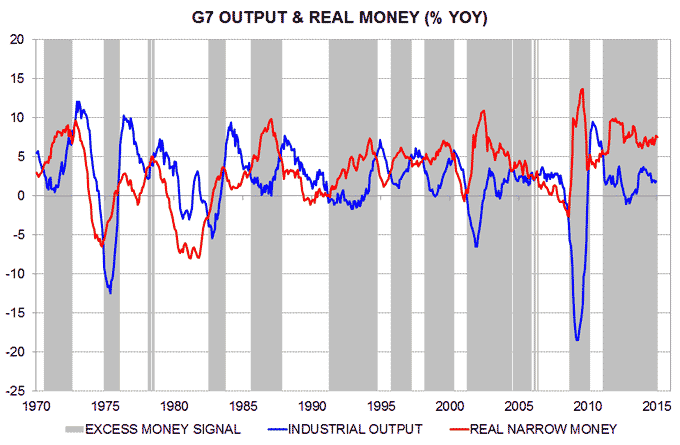
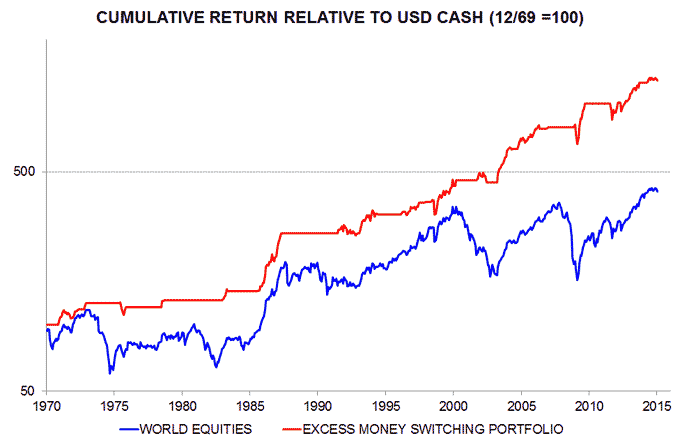
Global real money signalling strong H2 economy
Global growth has recovered since the summer, in line with a forecast based on monetary trends and leading indicators. This forecasting approach now suggests that growth will pull back slightly into the spring before moving higher again in the second half of 2015.
Global growth can be proxied on a timely basis by the six-month rate of change of industrial output in the G7 and seven large emerging economies (the “E7”). This bottomed in August 2014, rising to an eight-month high in December. A recovery had been signalled by strong G7 plus E7 real (i.e. inflation-adjusted) narrow money expansion in late 2013 / early 2014 and a subsequent increase in the composite longer leading indicator tracked here – see first chart.
Six-month G7 plus E7 output growth may remain around December’s level or move higher in January / February. Japanese production appears to have increased significantly in January – export volume rose by 5.0% – while G7 plus E7 output declined in July / August 2014, implying a favourable base effect.
G7 plus E7 real narrow money expansion, however, fell back in mid 2014, reaching a low in August before rebounding. The lead time of money to output has recently been somewhat longer than the historical average of about six months. The 2014 slowdown in real money, therefore, may be reflected in a pull-back in output growth this spring.
Any growth decline is likely to be modest and temporary for two reasons. First, the G7 plus E7 longer leading indicator has continued to trend higher; it has yet to confirm the loss of momentum suggested by monetary trends. Secondly, real narrow money expansion has rebounded strongly since the summer.
Real narrow money growth, indeed, appears to have reached its highest level since 2012 in January, based on data covering 60% of the G7 plus E7 aggregate. This mainly reflects an energy-driven plunge in inflation but, in addition, nominal money expansion appears to have increased significantly last month, reflecting a big rebound in Chinese M1 growth.
The latter surge, admittedly, is likely to be partly due to the late timing of the lunar New Year holiday. A reversal in Chinese M1 in February, however, may be offset by stronger growth in the US, based on monetary data for the first two weeks.
A fall in US real narrow money expansion last summer suggested that the economy would lose momentum in early 2015 – see second chart and post from September. This is playing out – the Citigroup US surprise index has moved deeper into negative territory – but monetary trends are now signalling economic reacceleration. Eurozone real money, meanwhile, is rising strongly and growth has picked up in Japan, with China probably now following. The global monetary backdrop, in other words, looks increasingly expansionary.


UK productivity stagnation extends
Inflationary risks from the UK labour market continue to increase. Today’s statistics show a further decline in labour availability, continued poor productivity performance and rising wage pressures.
The unemployment rate fell to 5.7% over October-December, the lowest since 2008 and down from 7.9% at the time of the last general election in May 2010. The short-term unemployment rate, measuring those out of work for six months or less, dropped to 2.8%, the lowest on record in data extending back to 1992 – see first chart. 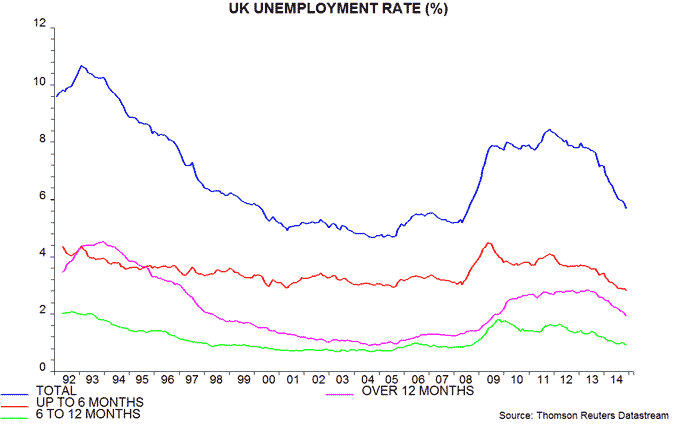
The more timely claimant count, meanwhile, dropped by a whopping 39k in January, suggesting that the overall unemployment rate will maintain its recent pace of decline of about 0.1 percentage point per month – the Bank of England, by contrast, expects a slower fall.
The implication of a growing labour shortage is supported by a further rise in the stock of unfilled vacancies to a record in data back to 2001.
The Bank of England last year claimed that rapid labour supply expansion would head off a shortage of workers. The labour force, however, expanded by only 0.4% in the year to the fourth quarter, well below the average annual growth rate of 0.9% since 2005 – second chart.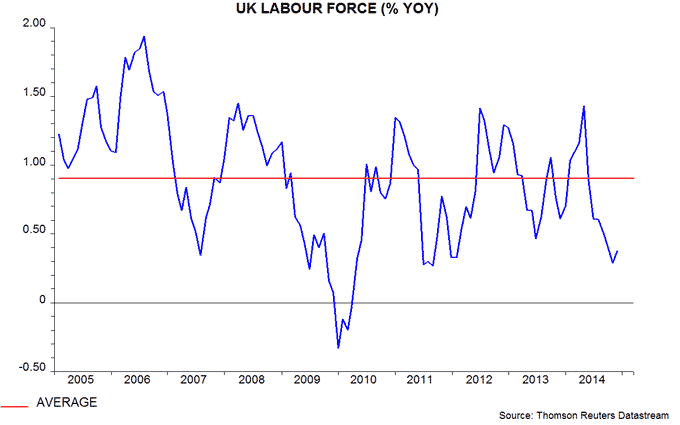
Bonus payments pushed up the annual growth rate of average weekly earnings to 2.4% in December but regular pay expansion eased back to 1.6% from 1.7% in November. Private regular earnings, however, increased at a 3.3% annualised rate between the third and fourth quarters, suggesting a pick-up in annual growth in early 2015 – third chart.
Productivity performance, meanwhile, remains dismal. Aggregate hours worked in the economy rose by 0.8% between the third and fourth quarters, exceeding the currently-estimated 0.5% rise in GDP. Flat productivity and a slow labour force rise suggest that trend GDP expansion is much weaker than implied by the Bank of England’s rosy forecast of strong medium-term growth coupled with sustained low inflation.
UK election model: Tory lift arriving too late?
A post in April last year described an economic model of UK voting intentions. This model suggested that the Conservatives would move into a 1-2 percentage point lead over Labour by the May 2015 general election, based on a plausible economic scenario. Updating the inputs, it continues to predict a 2 point Tory advantage by May but indicates that the gap would rise to 6 points by end-2015 in the absence of an election, as the economic backdrop continues to brighten. Conservative hopes of victory rest on persuading voters to give them credit for prospective as well as current good news.
The model is designed to predict the poll differential between the main government and opposition parties based on economic factors. It was estimated on ICM-Guardian poll data extending back to 1984. The poll differential depends positively on average earnings growth and house price inflation, and negatively on the unemployment rate, inflation and interest rates (Bank rate). More details are available in the previous post.
The Conservative-Labour differential swung from -3 percentage points in the January ICM-Guardian poll to +4 points in the February poll released this week. The model suggests that the latter result is an outlier and the “true” differential is currently -1 point – see chart. The Tories, however, are predicted to move into a 2 point lead by May, based on key assumptions that average earnings growth rises to 2.5% by then and consumer price inflation remains below 0.5%.
The problem for Conservative strategists is that the earnings pick-up may be occurring too late to swing the election result. The Bank of England expects earnings growth to rise further to 3.5% by late 2015. With inflation projected to remain low and unemployment to continue to decline, the Bank’s forecast implies that the Tory lead would widen to 6 points by end-2015 in the absence of an election, according to the model. A 6 point advantage in May would ensure a return to power.
The Conservatives are finally benefiting from an improving economy but their challenge is to convince voters that the recent recovery in real earnings is the start of a sustained upswing, for which they should receive electoral credit now.
UK Inflation Report: MPC fudges inflation implication of lower slack
Forecast changes in the February Inflation Report look internally inconsistent.
The MPC slashed its near-term inflation forecast to take account of recent commodity price weakness, with the annual CPI change now expected to fall to about zero in the second and third quarters of 2015. Surprisingly, it also lowered its medium-term projection: inflation in the first quarter of 2017, for example, is now forecast at 2.2% assuming unchanged policy, down from 2.4% in November.
The latter reduction is inconsistent with a significant downward revision to the MPC’s estimates of current and future spare capacity. Slack is estimated to be only about 0.5% of GDP at present, down from 1% in November, and is forecast to be eliminated within 18 months, versus two to three years previously.
Earlier elimination of spare capacity contributes to a stronger pick-up in average earnings growth, which reaches 3.5% and 4% in the fourth quarters of 2015 and 2016 respectively, a quarter-point higher than in November in both cases. With productivity assumptions little changed, unit labour cost growth climbs to 2% in late 2015 and 2.75% a year later.
Unit labour cost growth of 2.75% by late 2016 is incompatible with inflation remaining close to 2% in 2017, barring a major profits squeeze or further fall in import costs. The MPC may resolve this contradiction by raising its medium-term inflation forecast in May – after the general election.

